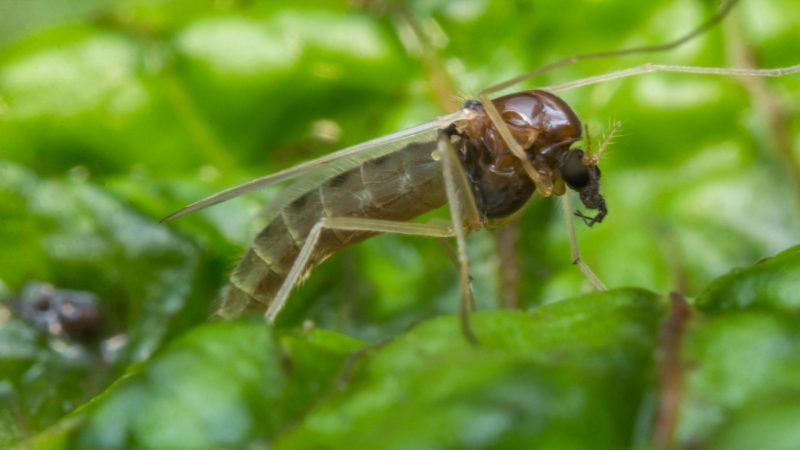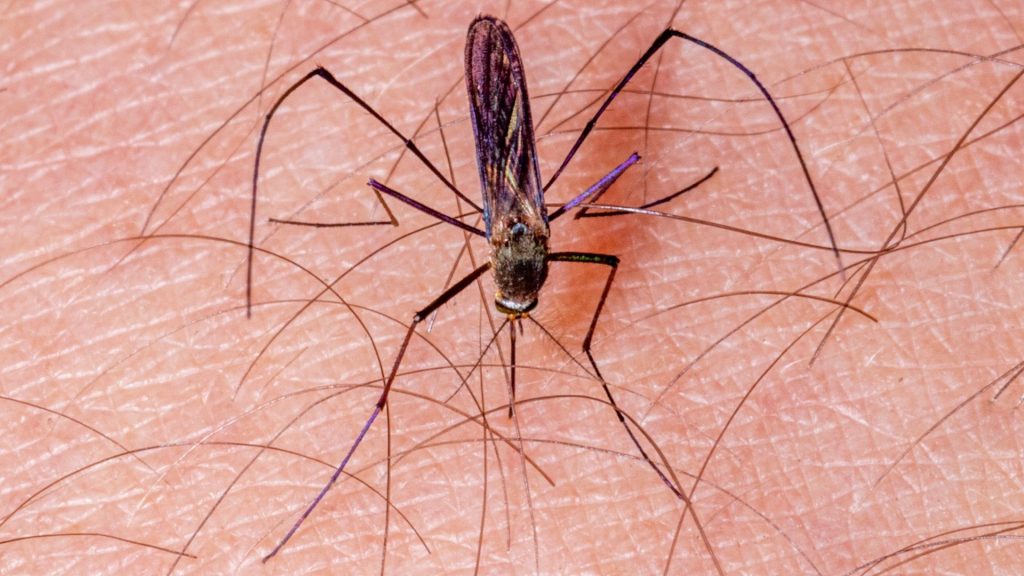The saying “small but terrible” seems to be a fitting description for no-see-ums. They are so small in size that they can pass through a screen door without you noticing it.
This may be due to the fact that most of these creatures only measure 3 millimeters in length. However, this does not mean that you have to take them for granted.
Despite their very tiny size, they have the capacity to cause painful bites that may be more excruciating than that of the mosquito.
Here are the effective techniques on how to get rid of no-see-ums:
- Clear the stagnant waters in your area.
- Keep your doors and windows closed, if possible.
- Place small mesh screens in your doors and windows.
- Turn on your air conditioning units.
- Use dehumidifiers indoors.
- Place insect-repelling herbs and spices indoors and outdoors.
- Use candles or fragrances containing essential oils.
- Apply natural or chemical insect sprays in your backyard.
- Maintain cleanliness of your indoor and outdoor areas.
Now that you have acquired valuable knowledge on how to get rid of no-see-ums, you may continue to orient yourself with these tiny insects by determining their nature, identifying characteristics, behavior, the health problems they bring, and other helpful strategies in keeping them away from your indoor or outdoor space.
What Are No-See-Ums?

No-see-ums are also known as biting midges or Ceratopogonidae. The family of the said insect has more or less 5,000 species, with 1,000 of them belonging only to the genus Colicoides.
They are endemic in almost all of the parts of the world, including the tropical, subtropical, coastal, and Caribbean regions. They have the capability to bite humans and the bites can progress into stinging and itchy, red lesions.
Other than that, they can also transmit illnesses such as Bluetongue disease, African horse sickness, and Epizootic hemorrhagic disease and pass on microorganisms like Mansonella nematodes and arboviruses.
Are No-See-Ums Mosquitoes?
No-see-ums are not necessarily mosquitoes. They are tiny insects belonging to the class Insecta, order Diptera, suborder Nematocera, infraorder Culicomorpha, superfamily Chironomoidea, family Ceratopogonidae.
However, they may be similar to mosquitoes in the sense that they can give itchy and painful bites to humans.
What Does No-See-Ums Look Like?
No-see-ums are typically ⅛ inch in length. They are gray in color and have two wings with a distinct colored pattern and a dense set of hairs. Their eyes are large in size and lie above a segmented antenna that houses the Johnston’s organ.
Also, their abdomen has nine segments that have smaller ends, while their thorax is slightly extended above the head. As to their mouthparts, they have a set of teeth that is specially designed for cutting and biting.
These are perfectly hinged on their mandibles that are somewhat stretched out and found in their proboscis.
Where Do No-See-Ums Live?

No-see-ums are generally found near bodies of water. They thrive in moist and swampy environments including ponds, marshes, lakes, and streams.
Also, they like to dwell in slow-moving and standing waters as they can freely move and glide over them. They are also present in cavities and gaps that are filled with water, such as tree holes or large basins and receptacles.
In some instances, there are species that can survive in brackish or salty waters.
Can No-See-Ums Live In Your Bed?
No-see-ums are unlikely to live in a bed. Their habitat is usually found in moist and damp places like streams, marshes, ponds, lakes, canals, and other areas where stagnant and slow-moving waters are abundant. A bed is far from these environments.
What Attracts No-See-Ums?
These small insects are greatly attracted to moisture and dampness. This is the reason why they are constantly found in slow-moving and stagnant waters.
Other than that, no-see-ums are also enticed by high levels of carbon dioxide and heat from humans which may imply an abundance of blood meal.
Lastly, they love the odor coming from people with increased lactic acid such as for overweight, pregnant, and physically active individuals.
How Long Do No-See-Ums Live?
The life cycle of no-see-ums is usually completed within two to six weeks, but in some cases, it may take up to a year.
However, this is not definite as it may depend on their species, environment, and breeding location. Thus, no-see-ums may live for at least six to seven weeks.
Do No-See-Ums Bite?

No-see-ums can bite humans. If they encounter people with increased levels of carbon dioxide, lactic acid, and heat, they will not hesitate to sting on them just to feed on their blood.
In general, only female no-see-ums have the ability to bite humans since they need it for the production of eggs. They do this habit during dusk or dawn but in some cases, they can also bite when the sun is out.
Their primary source of blood is mammals but they can also feed on the blood of reptiles, birds, and amphibians.
Related: Do Gnats Bite? | Best Gnat Repellent, Treatments, and More
Can No-See-Ums Bite Through Clothes?
No-see-ums may bite through clothes. Thus, it is advisable to wear light-colored, loose, and insect-mesh garments in order to reduce their incidents of biting.
They are typically three millimeters in length so it is easy for them to penetrate through certain fabrics.
Can No-See-Ums Bites Make You Sick?
No-see-ums can also bring various forms of sickness. These are the following:
Mansonellosis
Biting midges from the genus Culicoides have known vectors of filarial worms from the genus Mansonella.
When an infected no-see-um makes a puncture on a host’s skin, they can pass on the larval stage of the said parasites which will then reside on the pleural or peritoneal cavities.
Bluetongue Disease
The Culicoides species can also endanger the health and safety of domestic and wild animals like sheep, antelopes, elks, deers, camels, goats, and buffaloes.
Once these creatures are bitten, they may experience fever, lethargy, loss of weight, vomiting, diarrhea, ulcerations, bleeding and cyanotic episodes, and abortion if they are pregnant.
African Horse Sickness
The primary victims of this disease include horses, donkeys, zebras, camels, and mules. When these animals are bitten by infected biting midges, they may experience cardiac and respiratory problems like fever, edema, difficulty in breathing, coughing, frothy respiratory discharges, and in worst cases, cardiac failure and death.
Epizootic Hemorrhagic Disease
It is a viral disease that mainly affects white-tailed deers. The symptoms of this illness begin to emerge after at least seven days which may include fever, swelling, weakness, loss of appetite, and swollen head, neck, and other body parts.
Do No-See-Ums Carry Zika?
It is unlikely for no-see-ums to carry Zika. The said virus is passed on to humans primarily through the bites of infected Aedes aegypti and Aedes albopictus mosquitoes.
How Long Do No-See-Ums Bites Last?
The effects of no-see-um bites may last for up to two weeks. Their bites may go unnoticed at first or may leave a small red dot. However, the redness and swelling may become larger for up to 1 to 2 inches in diameter. The itchiness and mild pain may persist for up to 14 days.
How to Treat No-See-Ums Bites?
The following are the best strategies in treating no-see-um bites:
Step 1: Wash the bitten areas with running water and mild antibacterial soap.
Step 2: Do not scratch the bitten area. Apply ice pack or cold water to the bitten area as it will help ease itchiness.
Step 3: Put topical products such as zinc or analgesic creams on the bitten area to reduce pain, swelling, and intense itching.
Step 4: Take oral antihistamine medications.
What Time of Day Do No-See-Ums Come Out?
No-see-ums can go out at any time of the day. However, they are the most active when it’s dusk time or dawn. This is the time where they are at the peak of biting and sucking for blood.
How to Get Rid of No-See-Ums Naturally?

If you don’t want to deter no-see-ums through artificial or commercial means, you may opt to get rid of them using natural methods. This involves the utilization of natural strategies such as the following:
- Lessen or avoid, if possible, going outside or on areas where biting midges are prevalent during the dusk time or dawn.
- Use natural insect repellents.
- Wear protective clothing or garments that are loose-fitting, light-colored, or made from protective mesh.
- Turn on your air conditioning units as no-see-ums do not prefer cold temperatures.
- Use dehumidifiers to stabilize the humid condition of your indoor space.
- Place insect-repelling herbs and spices inside or outside your houses, such as mint, lemongrass, thyme, basil, lemon, citronella, eucalyptus, peppermint, rosemary, and oregano. You may also use candles or humidifiers containing essential oil versions of these plants.
- Keep your doors and windows closed, if possible. Also, fix the openings and holes of your doors and windows, if there are any. You may opt to use small mesh screens to prevent them from entering.
- Get rid of the potential breeding sites of no-see-ums by throwing away unused stagnant waters and regularly cleaning the surroundings.
What Essential Oils Repel No-See-Ums?
Here is a list of the essential oils that effectively repel no-see-ums:
- Cedar
- Rosemary
- Lavender
- Citronella
- Pine
- Lemongrass
- Peppermint
You can use it as an insect spray by mixing it with equal parts of water or incorporating it in humidifiers or aromatic candles.
How to Get Rid of No-See-Ums in Yard?
If no-see-ums are prevalent in your yard, it may be helpful to practice the following techniques:
- Discard unutilized stagnant waters as they may be used as a breeding site of no-see-ums.
- If it is not possible to throw away the said waters, you may opt to clean and replace them regularly.
- Apply natural or commercial insect repellent sprays.
- Maintain the cleanliness of your yard by removing any dirt or waste and properly closing the garbage bins.
How to Keep No-See-Ums Away?
To keep no-see-ums away, it may be beneficial to use the following products:
- Skeeta No-see-um Netting . If you are looking for a netting system that can keep no-see-ums away from you, this product is one of the best choices. It can efficiently protect you from insect bites as its ultra-fine mesh will prevent penetration of no-see-ums. Also, it is very lightweight and durable to use as it is made from 100% polyester netting material. It is also 54 inches wide and 5 yards long so it is definitely worth the money spent.
- . This natural insect repellent is one of the safest options. It is DEET-free, Picaridin-free, non-toxic, and made from 100% plant materials so protection from danger and toxicity is guaranteed. Also, it is non-staining, non-greasy, and non-irritating because of its pure vegan ingredients.
- Mesh Bug Suit for Outdoor Protection from Bugs, Flies, Gnats, No-See-Ums & Midges . Do you like to go outdoors but do not want to be bitten by no-see-ums? Worry no more as this product is one of the best solutions. It is made from a durable and breathable type of polyester material that can repel no-see-ums and other unwanted insects. Also, it is very easy to use as it is freely adjustable and can be conveniently worn or removed through its zippers. It is comfortable to wear and at the same time effective in keeping away no-see-ums at bay.
What Kills No-See-Ums?
Deterring the presence of no-see-ums may be done when you utilized the following products:
- Katchy Indoor Insect Trap . This trapping device works by enticing the insects through its UV rays and when they are attracted to go near it, they will be sucked inside through its fan and will be trapped in the glue board. It has adjustable settings and can be used conveniently by placing it in areas where insect pests are prevalent.
- Southern Ag 10401 Natural Pyrethrin Concentrate . This product contains 0.96% Pyrethrins and 9.6% Piperonyl Butoxide which are potent in killing insect pests such as no-see-ums. It is perfect for controlling pest infestation on ornamental plants, fruits, vegetables, livestock, and indoor spaces.
- BASF PT10239 PT 221L Pressurized Insecticide . This insecticide from the brand BASF contains 0.05% of Lambda Cyhalothrin that is very efficient in exterminating insect pests. It can be applied in a diverse range of locations such as homes, hospitals, hotels, resorts, restaurants, markets, schools, and other commercial and industrial buildings.
DIY No-See-Ums Sprays That Work?
If you want to make an effective DIY no-see-um spray, try this:
Step 1: Prepare the needed materials which include 1 part of yellow Listerine, 1 part of witch hazel, 2 to 3 drops of tea tree oil, a spray bottle, and a small bowl.
Step 2: Mix the yellow Listerine, witch hazel, and tea tree oil in the small bowl. Then, place the mixture in the spray bottle.
Step 3: Spray the mixture over the exposed skin at least once every 1 to 2 hours or when necessary.
Summary
No-see-ums are insects that can cause painful bites on humans. They are a threat since they can be vectors of diseases such as Mansonellosis, African Horse Sickness, Bluetongue Disease, and Epizootic Hemorrhagic Disease.
To get rid of them, you may employ natural methods such as the use of essential oils as repellents or you can buy commercial insecticide products that are toxic to insect pests.
Related: How to Get Rid of Gnats in House? | 9 Effective Ways
List of Sources
Connelly, C. (2019). Featured Creatures: Common Name: Biting Midges, No-See-Ums. University of Florida.
Insects and Ticks: Biting Midges. Purdue University.
Apperson, C., Waldvogel, M. (2019). Biting and Stinging: Biting Midges and Their Control. NC State University.
Mansonellosis. (2019). Centers for Disease Control and Prevention.
Epizootic Hemorrhagic Disease. Cornell University.
- How to Get Rid of Copperheads | Practical Guide - August 27, 2023
- How to Get Rid of Corn Snakes | What Makes Them Aggressive? - August 27, 2023
- How to Get Rid of Alligators | Safety Measures and Removal Methods - July 16, 2023
